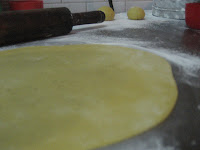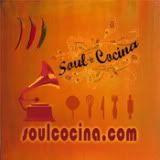 Chef Fernando on the djembe drum on stage at Fernando's Nostalgia Rest in Peace
Chef Fernando on the djembe drum on stage at Fernando's Nostalgia Rest in Peace
Chef Fernando was my Goan cuisine mentor. I studied and worked at Fernando's Nostalgia this time last year in the village of Raia. Chef Fernando loved traditional Goan cuisine and culture. He had worked in hotels and fancy restaurants cooking Indian, Portuguese, and "continental cuisine" (lovingly referred to as "Conti" in India) around the world. He was famous for his extravagant buffets. During my stay at Nostalgia, he often reminded me that we were "hard core"... and I new what he meant. After all of his years as a chef, he decided to return to his roots and cook traditional Goan cuisine from scratch. Slow food. All spice blends, masalas, doughs, stocks, everything from scratch. Check out this video I took of the kitchen at Nostalgia, to see how much work is involved in putting together one of Fernando's famous banquet feasts. You will see cooking out back, steaming sannas over a coconut shell fire, veg prep, peeling shrimp, then a trip through the bakery, into the pantry where canapes are being prepared, then into the kitchen where uncle is frying fish and auntie is grinding masalas.
Nostalgia Kitchen part I
Nostalgia Kitchen part II
As you see from the video, Chef Fernando orchestrated amazing banquet buffets in an unconventional style, using tradition and ingenuity to create unique events. Harry Partch was a ringleader with a similar vision. He worked outside of the box to create sounds and theater. Chef Fernando created flavors and drama through the culinary arts. Tune: Visions Fill The Eyes Of A Defeated Basketball Team In The Shower Room from Bewitched composed by Harry Partch performed by the University of Illinois Musical Ensemble and conducted by John Garvey.
Tune: Visions Fill The Eyes Of A Defeated Basketball Team In The Shower Room from Bewitched composed by Harry Partch performed by the University of Illinois Musical Ensemble and conducted by John Garvey.
"The Bewitched is in the tradition of world-wide ritual theatre. It is the opposite of specialized. I conceived and wrote it in California in the period 1952-55, following the several performances of my version of Sophocles' Oedipus. In spirit, if not wholly in content, it is a satyr-play. It is a seeking for release--through satire, whimsy, magic, ribaldry--from the catharsis of tragedy. It is an essay toward a miraculous abeyance of civilized rigidity, in the feeling that the modern spirit might thereby find some ancient and magical sense of rebirth. Each of the 12 scenes is a theatrical unfolding of nakedness, a psychological strip-tease, or--a diametric reversal, which has the effect of underlining the complementary character, the strange affinity, of seeming opposites." --Harry Partch
Chef Fernando became known as the top chef in all of Goa for traditional regional cuisine, made the old fashioned way. He was generous enough to share with me many of his famous recipes. Ambot Tik, Sannas, Cafreal, Rechaud, Balchao, Sorpatel, Xacuti, Goan Fish Curry, Goan Prawn Curry..... I also had the opportunity to work in his bakery which was a seperate building behind the main house of Nostalgia, under a mango tree, beside a fig tree, next to where the ducks, geese, and chickens used to chill. The desserts were elaborate. Mostly Goan pastries with strong Portugese roots like Dedos de Dama, Creme Caramel, and Sans Rival. Fernando loved music. Nostalgia is a true Soul Cocina. Bilimbi growing on a tree along the back of Fernando's Nostalgia. Notice Fernando's cat on the roof in the picture below.
Bilimbi growing on a tree along the back of Fernando's Nostalgia. Notice Fernando's cat on the roof in the picture below.
Bilimbi was a favorite ingredient of Chef Fernando. When I first met Chef Fernando, he invited me to share a meal and a drink with him in Nostalgia's tropical dining room. We had a huge feast that included prawn curry with bilimbis. I fell in love with this tart fruit that had the same texture and feel as star fruit. I was amazed when he showed me the fruit growing right beside the restaurant. Bilimbi, along with kokum gives the cocunut gravy a splendid sourness. Sometimes the prawns float alone in the gravy, sometimes they are accompanied by ladyfingers (okra), and they are usually accompanied by a few bilimbis, sliced in half lengthwise.
Here is a video I took of Auntie (one of Fernando's chefs) grinding coconut and spices for Goan Prawn Curry.
Goan Prawn Curry is served with boiled Goan red rice. In Goa it is known as local rice or boiled rice or ukade tandool. This rice is also popular in Southern Maharashtra, Karnataka, and Kerala.
Tune: Brown Rice by Don Cherry from the album Brown Rice which was origionally released under the title Don Cherry in the glorious year of 1975.

10 parts dry red chillies, deseeded
7 parts tamarind pulp
1 part tumeric powder
2 parts cumin seed
5 parts coriander seed
3 parts garlic
3 parts onion
Grind with water to a fine paste and strain and squeeze out all juices. repeat this process two more times.
Fry some chopped onions in oil and add some chopped tomatoes. Add the watered down masala paste (soymire) and bilimbi halves and optional okra slices along with a few pieces of kokum and a green chile, sliced in half. Simmer until bilimbi softens. Season with salt and add whole peeled prawns. Simmer until prawns are just cooked. Serve with boiled Goan rice and a glass of Sol Khadi.
..oh yeah... and don't forget the kismoor.
 The photo above is the fresh version of the mystery ingredient. The photo below is the dried version.
The photo above is the fresh version of the mystery ingredient. The photo below is the dried version. I first tasted this wonderful ingredient in a Parsi restaurant in Bombay called Britannia. Britania is one of the best restaurants in the world.
I first tasted this wonderful ingredient in a Parsi restaurant in Bombay called Britannia. Britania is one of the best restaurants in the world.Tune: Tom! Bac! and Stay by The Chemirani Trio from the 2002 album Kalam Kar THe Chemirani Trio are Master Persian musician Jamsid Chemirani and his two sons Keyvan and Bijan
Chemirani honors classical Persian music while incorporating influences from Africa, India and beyond. ...So does Zaman 8
Tune: Sani by Zaman 8 from the Six Degrees Emerging Artist Sampler CD.
Tune: ùë›é by Zadik Zecharia öãé÷ æëøéä from Kurdish Melodies Played on Zorna ›òéîåú ëåøãéåú òí æåø›ä
Zadik Zecharia is a Zorna master born in Kurdistan and living in Israel since 1950. Here is one of his songs remixed and tweeked by an Israeli DJ.
Tune: a Zadik Zecharia song Remixed By Kinoro Shel Rothschild from Kurdish Melodies Played on Zorna ›òéîåú ëåøãéåú òí æåø›ä Remixed
I bought this Zadik Zecharia CD at Aquarius Records in San Francisco.
Tune: Mervat by Salah Ragab & Thr Cairo Jazz Band from the album Ramadan in Space Time
Tune: A Farewell Theme by The Sun Ra Arkestra with Salah Ragab and The Cairo Jazz Band
Tune: Zeytinyagli by Mustafa Ozkent Orchestra from the album Genclik Elele

Tune: Sandalwood byMoondog and The London Saxophonic from the album Sax Pax for Sax
Tune: I Got the by Labi Siffre from the Remember My Song album released in the wonderful year of 1975.
Tune: Tavuklara Kiss De by Barış Manço
Tune: Küçük Bir Gece Müzigi also by Barış Manço
I felt at home cooking in Raia, just like Alborosie singing in Jamaica.
Tune: Kingston Town by Alborosie
Another European reggae act that stays real is Seeed. With a whole slew of records under their belt, they produce heavy riddims with a unique sound that is still reggae dancehall, but still different.
Tune: Dancehall Caballeros by Seeed
Tune: Music Monks by Seeed on the Pharoah Riddim
Tune: And Another Song by Seeed
Tune: Waterhouse Rock by Big Youth remixed by Groove Corporation from Select Cuts from Blood and Fire vol III
Tune: Disco Devil extended disco dub by Lee "Scratch" Perry and Max Romeo
Max Romeo's first job was working on a sugar plantation in 1958, so he is a natural Soul Cocinian. lee Scratch Perry is just crazy enough to be at home here at Soul Cocina as well.
Tune: Conquering Lion by Yabby You
Mystery Tune: ????What's This???? taken from a mixtape from the vaults of Albert T's Flying Saucer.
Mystery Tune: ??Mystery??? taken from a cassette tape bought on the streets of Calcutta.
Mystery Tune: ????Wha's This???? from an unlabeled white label 12"






























































